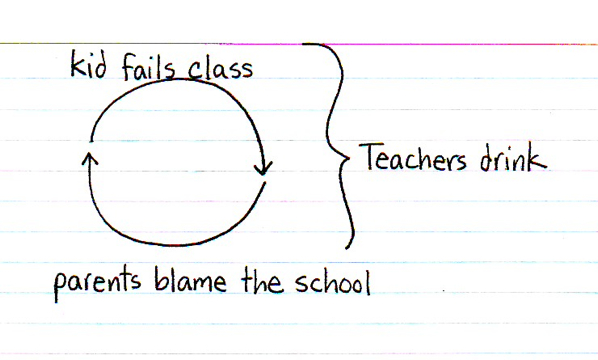Texas has been a vocal holdout on adopting Common Core State Standards (CCSS) since the beginning. Last week all 14 publishers who submitted high school biology textbooks for adoption in TX ignored the state’s demand to include creationism. I believe these two news items are directly related and reflect a huge shift in the market dynamics for instructional materials in the United States.
Articles Posted in Policy
When Tech Meets Schools – Frank Catalano
Frank has a great post over on Geekwire that does a great job of explaining why Dumbo Drops of tech don’t work in schools.

The question he didn’t completely address is why do people keep making this mistake?
One explanation is that a massive initiative that “attacks” a “problem” is far sexier than a thoughtful program to incrementally improve classroom practice. Don’t forget that many Superintendents are politicians. These things get headlines.
Why are AEP and the AAP School Division Merging?

The Association of Educational Publishers (AEP) and the Association of American Publishers School Division (AAP) announced their intent to merge last week. I’m currently the Board President at AEP. As one of the principals in the deal I thought it would be useful to share my perspective on why we are combining forces.
Common Core for Mortals

The Common Core Standards are causing a lot of angst across the world of education. Fortunately Brandt Redd is here to help.
Over at Of That he lays it all out in a lucid and well linked overview “The Common Core State Standards – For My Concerned Friends.” He cuts through the BS clearly and cleanly and describes how CCSS fits in the overall scheme of the Gates Foundation’s vision for personalized education.
Last week’s announcement by the Republican National Committee (RNC) that they are opposed to CCSS has added to the uncertainty hanging over the direction of the market in the next 3-4 years. If CCSS becomes more than minor skirmish in the political wars we’ll have a period of extended uncertainty about how materials should be crafted. The angry maw of lens hungry politicians could make a six course meal of various conspiracy theories.
Sequester Seschmester – Education Went Over the Cliff Last Year
 We’ve all heard the voices of DOOM about the looming budget cuts from the sequester. I call BS, at least as it affects K12 education.
We’ve all heard the voices of DOOM about the looming budget cuts from the sequester. I call BS, at least as it affects K12 education.
Laziness often drives how we talk about education funding. Because it is easy to track federal spending we focus our energy there. But this willfully ignores the plain fact that 90% of funding for education comes from state and local government, the Feds only account for 10%.
Do the math. A 10% sequester driven cut in Federal spending means a 1% cut to total education spending.
Secretary Duncan Calls for Digital Textbooks In Two Years – Four Essential Questions
Last Tuesday the Secretary of Education said
“I think we should be moving from print to digital absolutely as fast as we can over the next couple of years. Textbooks should be obsolete.”
He was clear that he sees the digital transformation in schools as a “critical game changer” for the American education system.
He gave three reasons for the advocating a rapid shift:
Education Reform Explained
UPDATE: For those who took offense at this graphic know that as I saw it the teachers’ drinking was a result of the cycle, not the cause. I interpreted this graphic as a slag on parents (myself included). If you are a teacher and were offended please accept my apology. If you are a parent and were offended – go volunteer in your local school. Regular readers will know that I have nothing but the highest respect for teachers.
One simple graphic from the always brilliant Jessica Hagy untangles the whole complicated mess.

Nuff said.
Market Crash or Market Stall?
 Is the instructional materials market in the tank? I’ve spoken with people at a dozen companies who are all seeing the same thing – since November 1st a moderately down market has dropped like a stone. A senior executive at one of the big 4 publishers flatly stated that this was the worst he’d seen it in 35 years. I’m inclined to agree.
Is the instructional materials market in the tank? I’ve spoken with people at a dozen companies who are all seeing the same thing – since November 1st a moderately down market has dropped like a stone. A senior executive at one of the big 4 publishers flatly stated that this was the worst he’d seen it in 35 years. I’m inclined to agree.
Since this appears to be an industry wide phenomena how should companies react? That depends on whether you think this is a temporary stall or a permanent realignment of funding for materials. How you see that depends on whether you focus on the supplemental or basal market.
For the supplemental market the evidence points towards a stall – at least so far. Low sales numbers don’t match the funding availability, there is no evidence that a huge amount of funding has been pulled from the market all of a sudden, What we do have is an abundance of uncertainty which is prompting districts to sit on the funds they have.
Monday Links
 In “Four years into the ebook revolution: things we know and things we don’t know” Mike Shatzkin does a great job of summarizing the state of the trade publishing business. Education Publishers take note – this is your future.
In “Four years into the ebook revolution: things we know and things we don’t know” Mike Shatzkin does a great job of summarizing the state of the trade publishing business. Education Publishers take note – this is your future.
In “Predicting Player Behavior and How Zynga Profits From Data Analysis” John Rice picks apart the Wall St. Journal’s article (paywall) with an eye to education. Talk about data driven business models is all the rage in EdTech – this is what it really looks like. Money quote:
“We feel that a purely data-driven approach has significant promise for creating accurate predictive models of player behavior in games without the difficulties associated with earlier modeling techniques.”
Stephen Coller at the Gates Foundation has a new blog Forking Education about their open source work on the Shared Learning Infrastructure (SLI), the Learning Resources Metadata Initiative (LRMI), and Learning Maps among other things. I’m not sure if the title is meant to evoke poking a fork to stir things up or if it is a bad pun.
Is The Internet Making Kids Smarter? – The Brain Doctor Weighs In
 Ed Note: One of my favorite thinkers and practitioners on engaging kids deeply with Math and Science is Jim Bower. Jim is that rare combination of theorist and practitioner who is successful in both realms. He is both a Professor of Neuroscience at UTSA and the Founder/CEO of Whyville.net, arguably the stickiest web destination for learning ever created.
Ed Note: One of my favorite thinkers and practitioners on engaging kids deeply with Math and Science is Jim Bower. Jim is that rare combination of theorist and practitioner who is successful in both realms. He is both a Professor of Neuroscience at UTSA and the Founder/CEO of Whyville.net, arguably the stickiest web destination for learning ever created.
Jim has strong opinions, but he has earned the right to hold them through deep thinking and risk taking that applies his theories successfully in the real/virtual world.
Please invest the time to read Jim’s post where he challenges us to see why the web is making us smarter, not dumber. The TEDx video then answers the question of exactly how you do this.
 The Education Business Blog
The Education Business Blog

